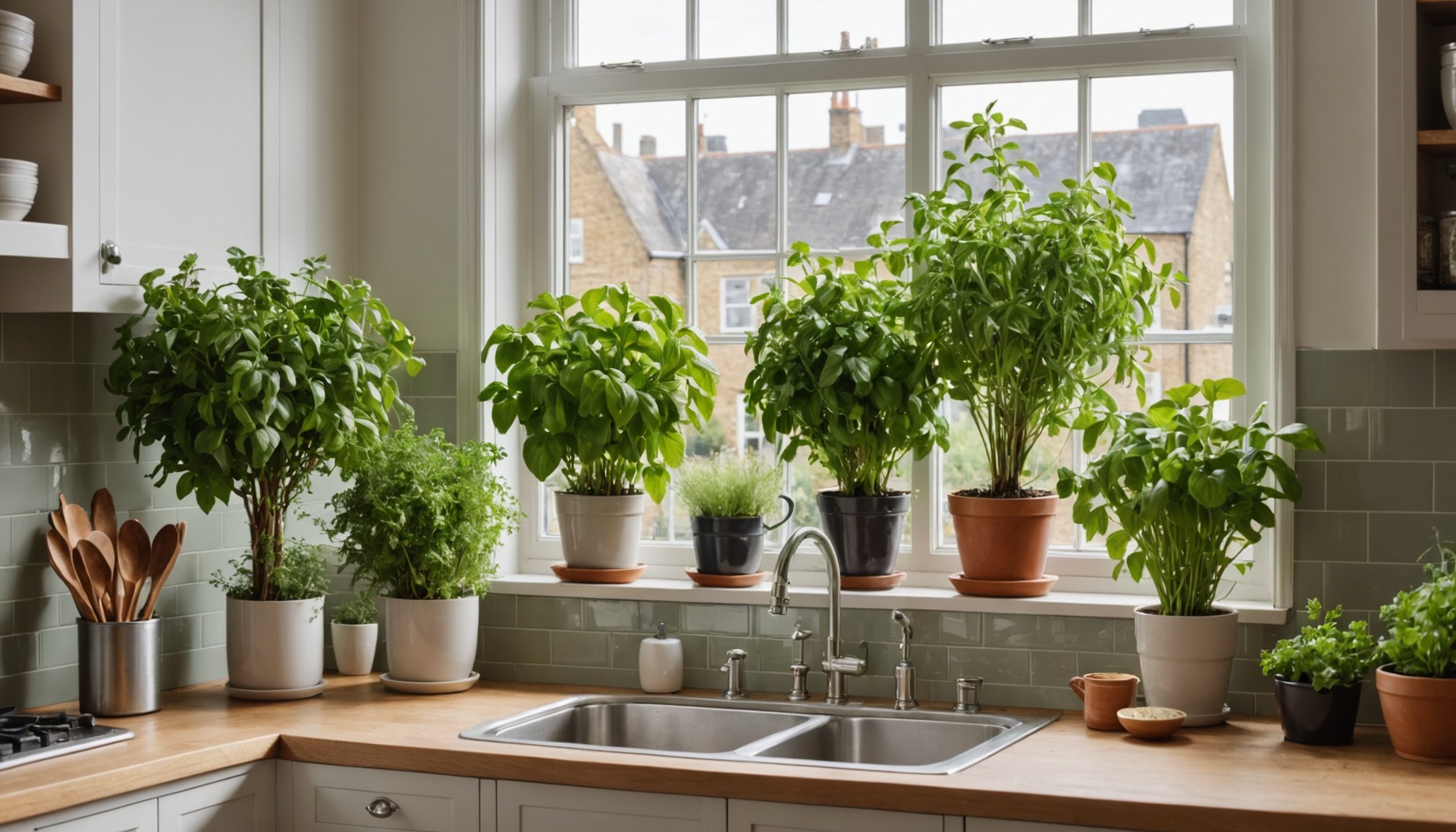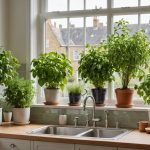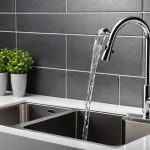Understanding Your Space
When establishing an indoor herb garden layout in your kitchen, one of the critical considerations is assessing the light conditions. Herbs thrive in bright environments, making it essential to identify areas with ample sunlight. Ideally, aim for a location that receives at least 6-8 hours of sunlight daily.
Selecting the right window is pivotal. Southern-facing windows often provide the most consistent light exposure, while eastern and western exposures can also be beneficial. Avoid northern-facing windows as they might not offer sufficient light for most herbs. If natural light is limited, consider using grow lights to ensure your herbs flourish.
In the same genre : Ultimate guide to selecting the ideal uk kitchen tap: effective strategies for reducing water waste
Space constraints can be a challenge, but with thoughtful planning, you can maximize your available area. Vertical gardening is an innovative solution for tight spaces, allowing you to stack pots or use wall-mounted containers. Choose pots that fit comfortably on windowsills or countertops to keep your herbs accessible and aesthetically pleasing.
For those with extremely limited space, consider compact options like hanging baskets or tiered trays. These solutions not only save space but also create a visually appealing display. By understanding your kitchen’s unique light conditions and space limitations, you can design an indoor herb garden layout that suits your needs and enhances your culinary experiences.
Also to discover : The essential handbook for selecting the ideal cast iron skillet for your uk culinary needs
Selecting the Best Herbs for a UK Kitchen
Choosing the right herbs for indoor gardening in the UK involves understanding both growth requirements and seasonal considerations. Popular choices include basil, mint, and rosemary. These herbs not only enhance your culinary dishes but also bring freshness and vitality to your kitchen space.
Herb Selection Criteria
When considering herb selection for your kitchen, focus on those that thrive indoors. Basil, for instance, enjoys warmth and should be placed in a sunny spot. Conversely, mint prefers cooler environments and can even thrive in less direct sunlight.
It’s important to pay attention to each herb’s seasonal growth requirements. Some, like parsley, can be grown year-round, while others might have specific growing seasons.
Balancing Aesthetics and Culinary Use
While selecting herbs, it’s key to balance both visual appeal and culinary usefulness. Rosemary’s robust foliage can add a touch of greenery, while its flavour enhances many dishes. Steel yourself against the tempting aroma of basil, which offers aesthetic charm and culinary versatility.
Consider arranging your herb garden aesthetically—intermix tall herbs like rosemary with sprawling ones like mint to create visual interest. This approach not only keeps your kitchen vibrant but also turns it into a functional culinary haven.
Potting and Soil Requirements
Proper potting techniques are crucial for the healthy growth of indoor herbs. Choosing the right pot size and material is a fundamental step. Recommended pot sizes vary depending on the herb type, but generally, pots with a diameter of 6 to 12 inches are suitable for most indoor herbs. Avoid cramming multiple plants into small containers, as this can restrict root growth.
Materials for pots can range from plastic and ceramic to clay. Each material has its own benefits—plastic pots are lightweight and affordable, while clay pots offer better moisture retention and aeration. The importance of drainage cannot be overstated. Ensure that pots have drainage holes to prevent waterlogging, which can lead to root rot.
When it comes to soil mixes, the best options for indoor herbs are those that ensure good drainage and air circulation. A mix of potting soil, perlite, and coarse sand often works well. Organic matter such as compost can enrich the soil and improve moisture retention.
Key potting techniques to remember include proper layering of soil components and careful planting to avoid damaging roots. With attention to these details, your indoor herbs will have the best chance to thrive and flourish.
Maintenance and Care Tips
Effective maintenance is essential for healthy herb growth. Understanding herb care is crucial to ensure strong and flourishing plants.
First, knowing how to water correctly is key. A consistent watering schedule helps avoid the pitfalls of over or underwatering. Signs of overwatering include yellow leaves and drooping, while underwatered herbs may have dry, brittle leaves and stunted growth. Adjust your schedule based on environmental conditions, season, and the specific needs of each herb.
Fertilization plays a vital role in optimal growth. Use a balanced, all-purpose fertiliser designed for herbs. Apply as per the instructions, typically every four to six weeks, to ensure herbs receive essential nutrients. Remember, over-fertilisation can lead to lush foliage but less flavourful leaves. Observing a plant’s response, such as changes in leaf colour or reduced growth, can inform necessary adjustments.
Pruning techniques not only maintain shape but also encourage bushier plants. Regularly prune to remove dead or yellowing leaves, and trim tips to foster branching and fuller growth. For best results, use sharp, clean scissors or pruning shears to avoid damage. Pruning approximately every two weeks can substantially support plant health and productivity.
Incorporating these strategies into your herb care routine ensures a bountiful and vibrant garden.
Troubleshooting Common Issues
Growing indoor herbs can sometimes be accompanied by challenges, including pests, diseases, and poor plant health. Understanding these common issues and knowing how to address them can help maintain a thriving herb garden within your home.
Identifying and Dealing with Pests
One of the primary challenges of indoor herb gardening is pest control. Tiny invaders like aphids, spider mites, and whiteflies can wreak havoc on your plants. Quickly recognizing these pests is crucial. Look for signs like sticky leaves, webbing, or damaged foliage. Introducing natural predators such as ladybugs can help manage these pests organically. Alternatively, a gentle spray of water mixed with mild soap provides an effective initial defence against these invaders.
Handling Diseases Affecting Indoor Plants
Herbs are also susceptible to diseases, including powdery mildew and root rot. Ensure your plants receive adequate airflow and avoid overwatering to prevent these issues. Using a fungicidal spray can help contain outbreaks if detected early. Regularly inspect your plants for tell-tale signs like white powdery spots or wilting.
Solutions for Poor Growth and Leaf Discoloration
Poor growth or leaf discoloration can indicate underlying issues like nutrient deficiencies. Ensure your herbs receive ample sunlight and use fertilisers tailored for herbs to combat this. Consider soil quality and ensure it is well-draining and enriched with organic matter to promote healthy growth.
Culinary Uses of Your Homegrown Herbs
Cooking with herbs opens up a world of vibrant flavours and versatility in your kitchen. Imagine transforming simple ingredients into gourmet delights with a sprinkle of fresh basil or a sprig of rosemary.
Simple recipes can highlight the essence of your homegrown herbs. For instance, an easy-to-make pesto uses a handful of basil leaves, pine nuts, garlic, Parmesan cheese, and olive oil. Blend them together, and you’ve got a delicious sauce perfect for pasta, sandwiches, or salads.
Preserving your excess herbs ensures you can enjoy their flavours all year long. Techniques like air drying, freezing, or using them in herb butter are excellent ways to maintain their potency. Finely chop herbs like parsley and mix with butter; roll the mixture and freeze for a herb-infused enhancement to any dish.
Enhancing your favourite dishes with these fresh flavours can elevate even the simplest of meals. A touch of mint in a summer salad or a sprinkle of thyme on roasted vegetables can transform your culinary creations. Not only do they add taste, but these herbs also infuse dishes with a delightful aroma, making your kitchen a more inviting place.
Visual Inspiration and Ideas
Setting up an herb garden isn’t just about cultivating useful plants; it’s also an opportunity to enhance your kitchen’s aesthetics. Whether you have a sprawling outdoor space or just a cozy window sill, the right styling can transform your herb garden into a captivating feature.
Styling tips can dramatically uplift how you display herb pots. Consider using a variety of containers, from rustic terracotta to sleek modern ceramics, to match your kitchen’s decor. It’s a great idea to experiment with different heights and textures. For instance, place taller rosemary in the back, with trailing thyme up front in a hanging planter.
Combining herbs with decorative items further enhances their aesthetic appeal. Pair small potted herbs with kitchen items like vintage scales or rustic cutting boards. These combinations are not only visually pleasing but help to integrate the garden seamlessly into your home environment.
There are numerous examples of successful herb garden setups in homes across the UK. Some enthusiasts opt for vertical gardens using wall-mounted pots, whilst others prefer neatly arranged countertop herb collections. This tangibly shows how thoughtful design can make a functional herb garden also a stunning visual component in your kitchen.











